

William Stopford
Every SUV, ute and van discontinued in Australia in 2025
10 Hours Ago
Wrangler or Bronco? We'd wager plenty of people are already asking the question – so here's how they stack up side-by-side.

Design Contributor
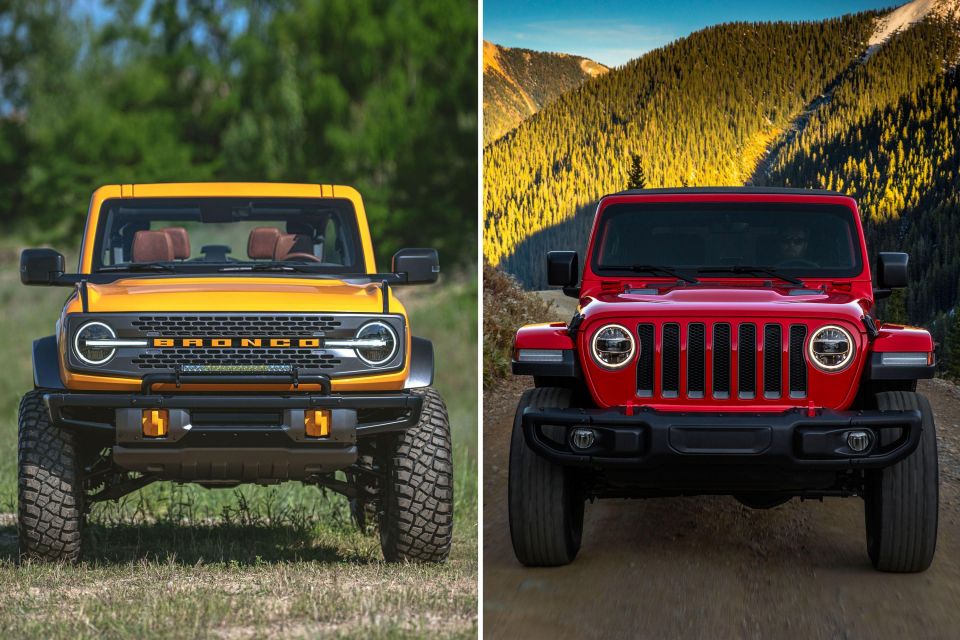

Design Contributor
The Jeep Wrangler is undeniably one of the most iconic American vehicles of all time, with body-on-frame architecture, traditional 4×4 proportions and rugged looks derived from the Willys.
With the world gradually turning to softer SUVs, the Wrangler was left untouched by the competition until Ford launched the new Bronco. The sixth-generation Bronco (the first since 1996) is a direct competitor to the fourth-generation Wrangler, combining nostalgic looks and rugged off-road capabilities with the help of new technology.
This imminent rivalry for the purist’s 4×4 sales crown in 2021 inspired our latest Design Battle.
The sixth-generation Bronco was unveiled digitally in July 2020 as the flagship of the Bronco sub-brand, after a long teaser campaign. It’s available in two-door and four-door body styles with removable doors and roof panels (hard-top or soft-top).
Designer: Paul Wraith, Ford Bronco chief designer Engine: Four-cylinder EcoBoost 2.3L (201kW/420Nm) or EcoBoost 2.7L V6 (231kW/542Nm) Transmission: Seven-speed manual, 10-speed automatic Dimensions: 4412–4440mm long, 1928-2014mm wide, 1826-1875mm tall, 2550mm wheelbase (two-door) // 4790mm long, 1880mm wide, 1869mm tall, 3010 mm wheelbase (four-door). Approach angle: 35.5-43.2 degrees Break over angle: 20-29 degrees Departure angle: 29.7-37.2 degrees Ground clearance: 211-295mm Wading depth: 850mm
The fourth generation of the Wrangler (JL) was unveiled in November 2017 at the Los Angeles motor show.
It’s available in two-and four-door body styles, with removable doors and windscreen from aluminium, and three removable roof options: Freedom top (fibreglass hardtop), Sunrider (soft top) and Sky One-Touch (electronically operated soft top).
The Wrangler serves as a base for the Jeep Gladiator, which was unveiled in 2019 with a five-seater cabin and a pick-up bed.
Designer: Mark Allen, Chief Designer at Jeep Engine: 2.0-litre four-cylinder mild-hybrid e-Torque (201 kW/393 Nm), 3.6-litre Pentastar V6 mild-hybrid e-Torque (213 kW/ 353 Nm), or 3.0-litre EcoDiesel V6 (194 kW/600 Nm) Transmission: Six-speed manual, eight-speed automatic Dimensions: 4240mm long, 1880mm wide, 1869 mm tall, 2460mm wheelbase (two-door) // 4811-4839mm long, 1928-2014mm wide, 1854-1913mm tall, 2949mm wheelbase (four-door). Approach angle: 41.4-44 degrees Break over angle: 21-27.8 degrees Departure angle: 35.9-37 degrees Ground clearance: 246-277mm Wading depth: 762mm

Ford Bronco
For the design of the new Bronco, Ford designers took inspiration from the first-generation model (1965), retaining similar but modernised proportions and design details.
The front end of the Bronco is dominated by the massive grille graphic, housing the round LED headlights and vertical LED bars, with Bronco lettering.
Below, the off-road bumper with fog lights and exposed tow hooks can be optionally replaced by heavy-duty modular steel bumpers and protective skid plates. The trail sights on the edges of the bonnet serve as tie-downs for securing larger items on the roof, while maintaining a visual connection with the first-gen Bronco.
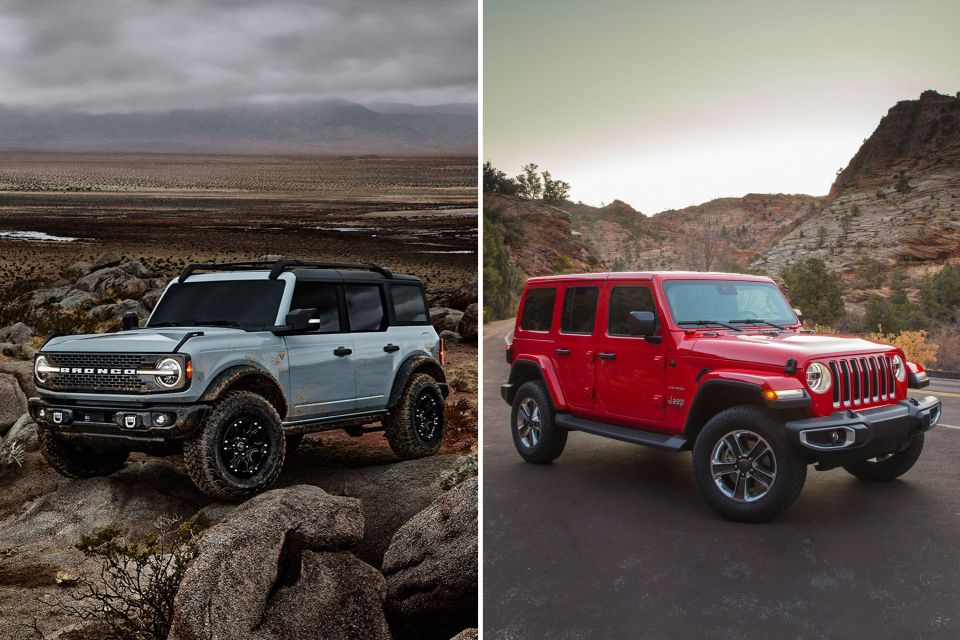

Jeep Wrangler
You don’t mess with an icon and this is why the designers at Jeep chose an evolutionary approach for the Wrangler. The latest model retains many of the classic design elements of its predecessors but manages to look more muscular and modern thanks to clever details.
The classic face of the Wrangler is created by the upright seven-slit Jeep grille, invaded by the LED round headlights that dictate the shape of the long bonnet with rounded edges and integrated vents.
The wide track is emphasised by the signature add-on fenders with extra LED lights, leaving part of the tires exposed. The rugged looks are complemented by the black-coloured off-road bumper with integrated fog lights and the upright, flat and retractable windshield.
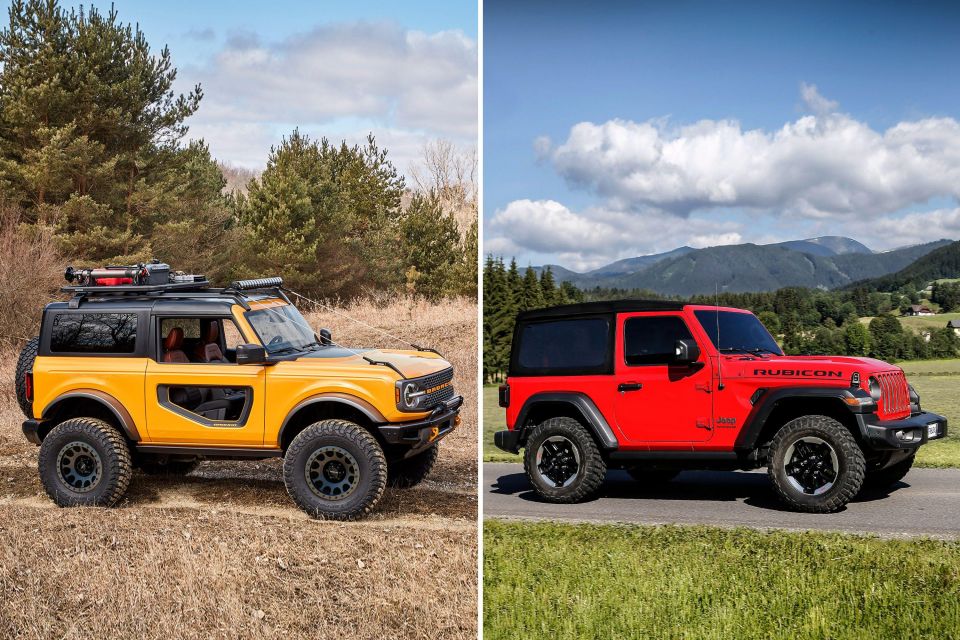
Ford Bronco
From the side, the new Bronco has the form-follows-function proportions of a rugged 4×4 with a boxy shape, large wheels, short overhangs, vertical front and rear ends, upright windshield, flat surfaces and horizontal dynamic lines. There are also black flared fenders to cover the wide tracks.
The modular and removable hard-top (also available with soft-top) consists of three or four parts. Similarly, the removable doors (optional doors with added windows) can fit inside the trunk of the four-door version.
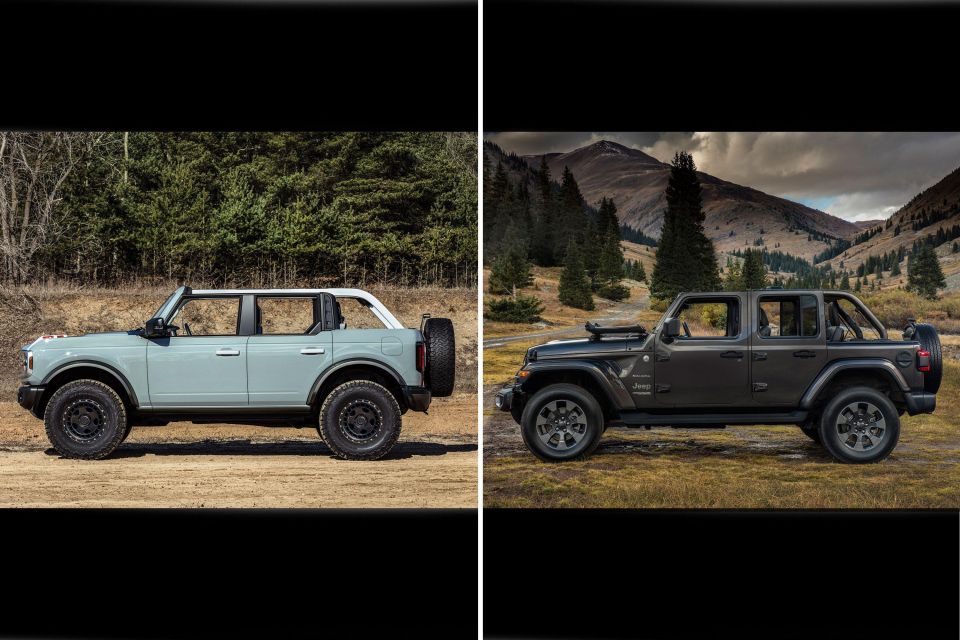
Jeep Wrangler
The Wrangler has grown in size but it retains the proportions that make it instantly recognisable – long bonnet, laid-back front with almost no overhang, flat doors with external hinges, horizontal belt line and boxy wheel arches with flared fenders.
Like in every Wrangler, the aluminium doors (optionally available with integrated windows) and roof panels are removable for an open-air experience, especially when combined with the flip-down windshield coming from the Willys days.
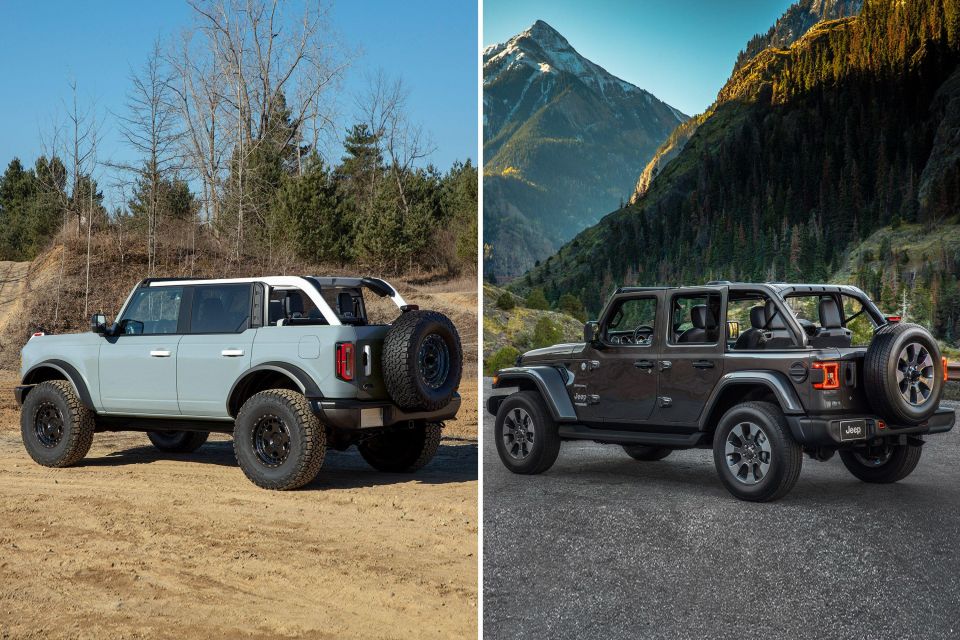
Ford Bronco
Ford didn’t provide many photos of the Bronco’s rear, but from what we can see it has a minimalist design with a vertical stance, the must-have external spare wheel, side-hinged rear door and top-hinged rear window, an asymmetrical rear bumper with the plates on the left side, and vertically positioned taillights with LED graphics.
When the hard-top and rear quarter panels are in place, the Bronco has an upright rear end for a classic boxy shape with rounded edges. When removed, the integrated roll-cage is inclined for a sportier stance.
Jeep Wrangler
The rear section of the Wrangler is characterised by the large, cube-shaped taillights with LED graphics, bringing a modern look despite the overall retro appearance. The external spare wheel is mounted on the side-hinged rear door, together with the third brake light, while the thin rear bumper is asymmetrical.
When the hard-top is in place, the top-mounted rear windshield sits at an almost vertical angle and continues the low belt line of the side windows. The protective roll-cage underneath it has a sporty angle towards the back.
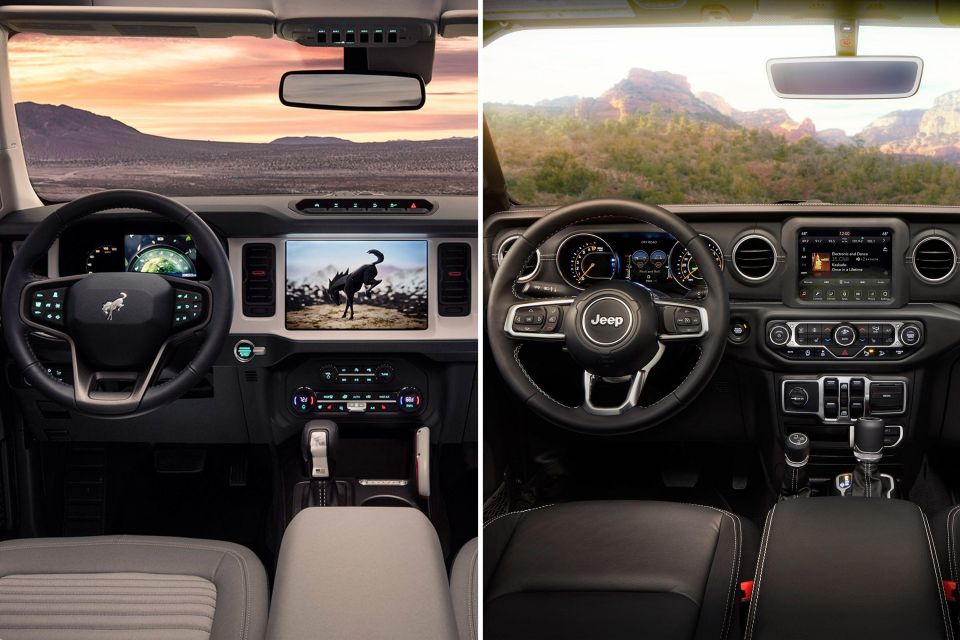
Ford Bronco
Inside the cabin, we find a 12-inch central touchscreen (8.0-inch on base models) with the latest Sync 4 infotainment including a 360-degree camera, off road navigation, and smartphone integration (Apple CarPlay and Android Auto).
It is accompanied by a digital instrument panel with graphics inspired by the first-gen Bronco. The steering wheel has integrated buttons and features the Bronco horse emblem.
Physical controls for the climate control are located under the screen while there are four vertical climate vents. On the central tunnel we find the gearbox lever, two cup holders, and the circular dial for the Terrain Management System.
The interior trim depicts the colours of the wild west. There are washable rubberised floors with integrated drains, wipeable surfaces and silicon protection for the switches.
The high-strength steel roll cage protects the passengers, while practical solutions like hooks mounted in the seat backs, attachment points for smartphones and cameras on the dashboard and extra grab handles. Last but not least, the trunk has a sliding floor which expands.
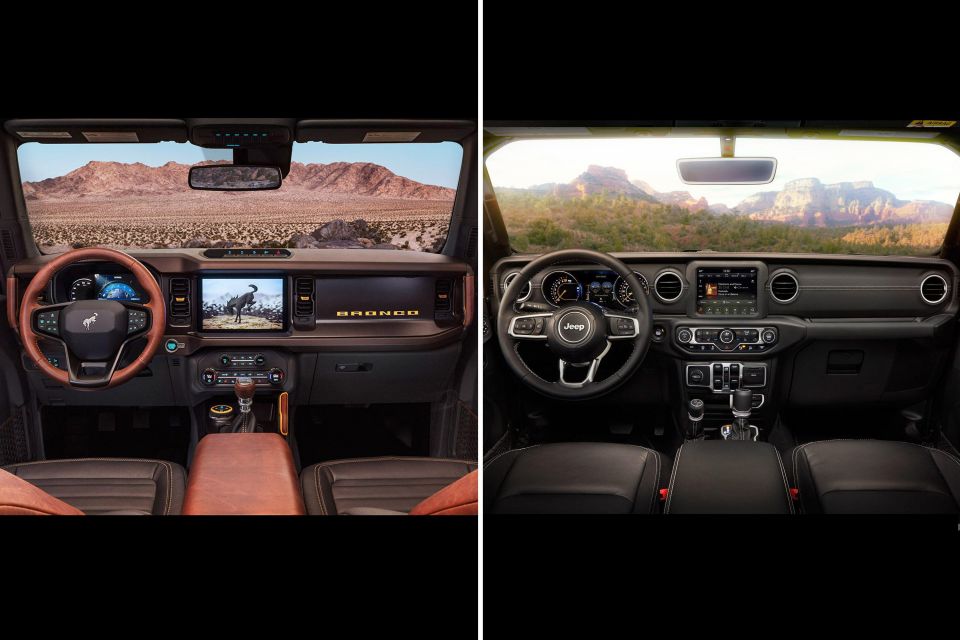
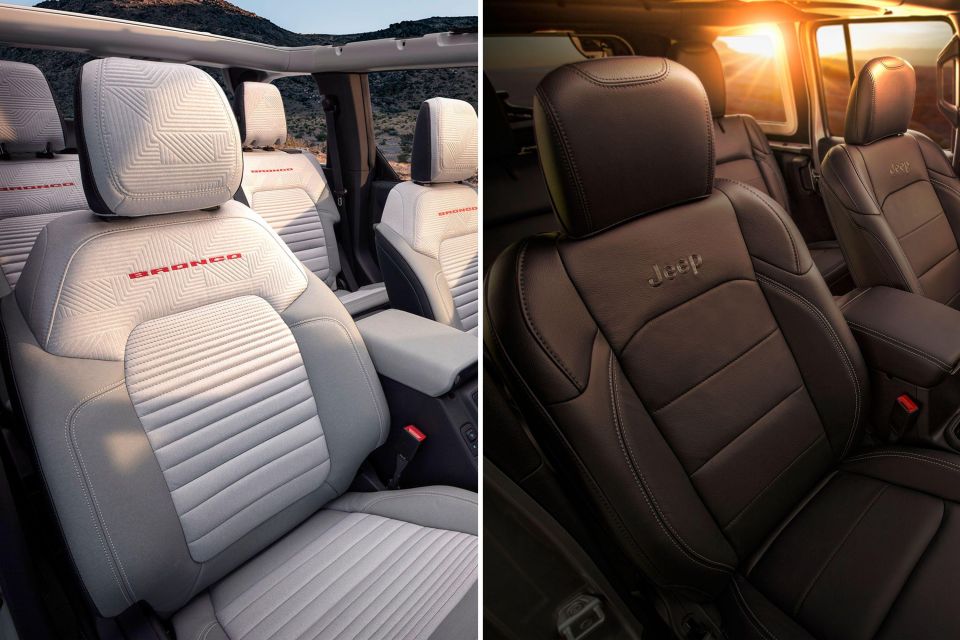
Jeep Wrangler
The interior of the Wrangler is a step-up from its predecessor in terms of technology and design. A central 8.4-inch touchscreen (5.0- or 7.0-inch base) for the Uconnect 5 infotainment is flanked by round climate vents.
Below there is an array of physical buttons, knobs, and switches for the dual-zone climate control, the electric windows and transfer case.
Behind the retro three-spoke heated steering wheel with the Jeep logo, we find analogue dials and a screen in the middle of the instrument cluster.
On the other side there is a grab handle with Wrangler lettering. The heated seats are upholstered in either cloth or leather. There is also an Alpine Premium Audio System with nine speakers, an overhead sound bar, all-weather subwoofer and 552-watt amplifier.
On the practical side, there is an adaptable cargo space with optional Trail Rail system and removable cargo floor, weather resistant removable carpet and one-way floor drain valves for easier cleaning.
Which one would you prefer?Made here

William Stopford
10 Hours Ago


Ben Zachariah
11 Hours Ago


Derek Fung
11 Hours Ago


Matt Campbell
18 Hours Ago


William Stopford
1 Day Ago


Josh Nevett
1 Day Ago